light MAZDA MODEL 3 HATCHBACK 2020 (in English) Owner's Manual
[x] Cancel search | Manufacturer: MAZDA, Model Year: 2020, Model line: MODEL 3 HATCHBACK, Model: MAZDA MODEL 3 HATCHBACK 2020Pages: 598, PDF Size: 89.37 MB
Page 65 of 598
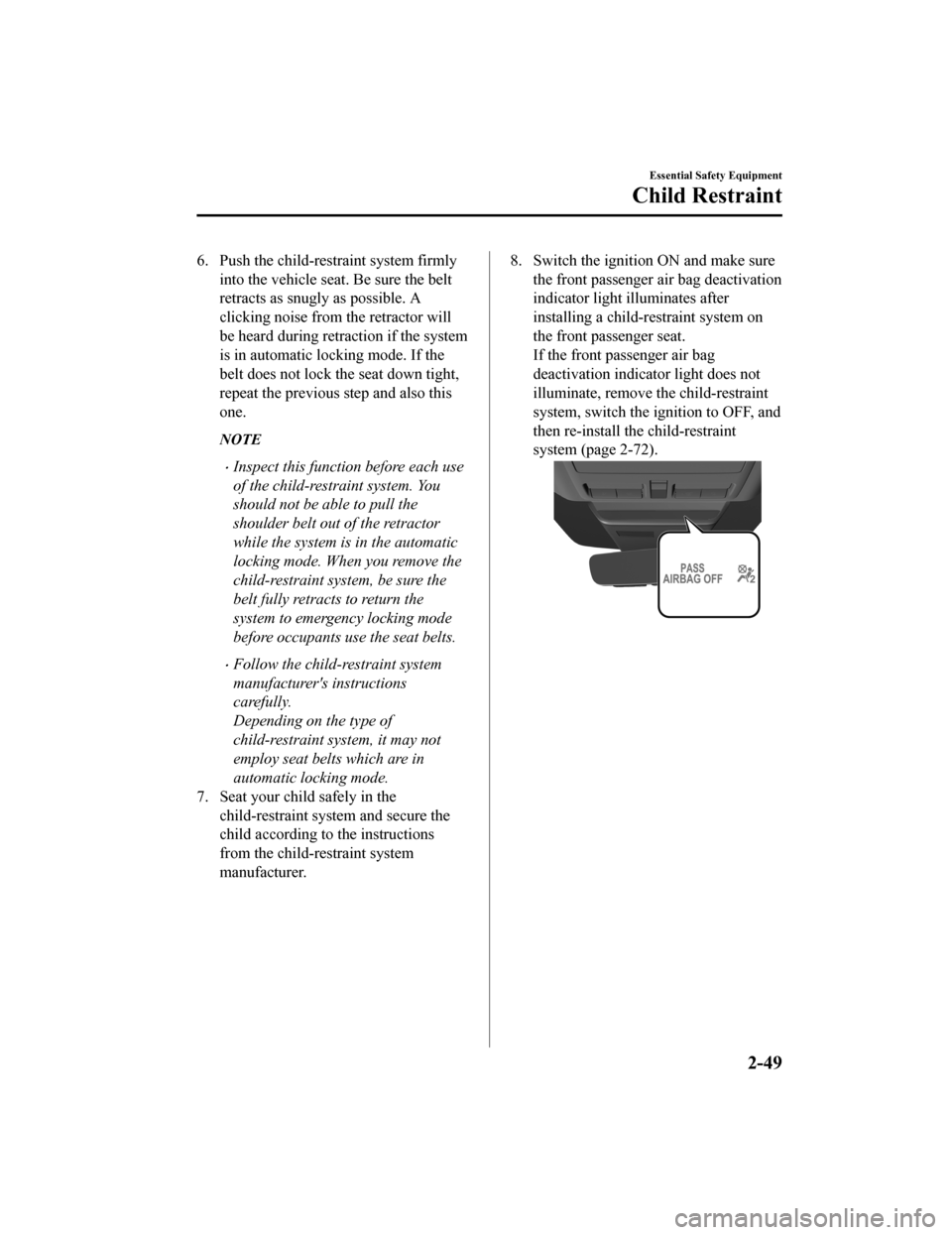
6. Push the child-restraint system firmlyinto the vehicle seat. Be sure the belt
retracts as snugly as possible. A
clicking noise from the retractor will
be heard during retraction if the system
is in automatic locking mode. If the
belt does not lock the seat down tight,
repeat the previous step and also this
one.
NOTE
Inspect this function before each use
of the child-rest raint system. You
should not be able to pull the
shoulder belt out of the retractor
while the system is in the automatic
locking mode. When you remove the
child-restraint system, be sure the
belt fully retracts to return the
system to emergency locking mode
before occupants use the seat belts.
Follow the child- restraint system
manufacturer's instructions
carefully.
Depending on the type of
child-restraint sy stem, it may not
employ seat belts which are in
automatic locking mode.
7. Seat your child safely in the
child-restraint sy stem and secure the
child according to the instructions
from the child-restraint system
manufacturer.
8. Switch the ignition ON and make sure the front passenger air bag deactivation
indicator light illuminates after
installing a child-restraint system on
the front passenger seat.
If the front passenger air bag
deactivation indicator light does not
illuminate, remove the child-restraint
system, switch the i gnition to OFF, and
then re-install th e child-restraint
system (page 2-72).
Essential Safety Equipment
Child Restraint
2-49
Mazda3_8HZ1-EA-19G_Edition1_old 2019-5-17 13:49:03
Page 66 of 598

WA R N I N G
Do not seat a child in a child-restraint
system on the front passenger seat if the
front passenger air bag deactivation
indicator light does not illuminate:
While it is always better to install any
child-restraint system on the rear seat, it is
imperative that a child-restraint system
ONLY be used on the front passenger seat if
the deactivation indicator light illuminates
when the child is seated in the
child-restraint system (page 2-72). Seating
a child in a child-restraint system installed
on the front passenger seat with the front
passenger air bag deactivation indicator
light not illuminated is dangerous. If this
indicator light does not illuminate, this
means that the front passenger front and
side air bags, and knee air bags, and seat
belt pretensioners are ready for
deployment. If an accident were to deploy
an air bag, a child in a child-restraint
system sitting in the front passenger seat
could be seriously injured or killed. If the
indicator light does not illuminate after
seating a child in a child-restraint system
on the front passenger seat, seat a child in
a child-restraint system on the rear seat
and consult an Authorized Mazda Dealer
as soon as possible.
▼ Using ISOFIX Lower Anchor
(Mexico)/Using LATCH Lower
Anchor (Except Mexico)
Your Mazda is equipped with ISOFIX/
LATCH
*1 lower anchors for attachment of
specially designed ISOFIX/LATCH
*1
child-restraint systems in the rear seats.
Both anchors must be used, otherwise the
seat will bounce around and put the child
in danger. Most ISOFIX/LATCH
*1
child-restraint system s must also be used
in conjunction with a te ther to be effective.
If they have a tether you must use it to
better assure your child's safety.
WA R N I N G
Follow the manufacturer's instructions for
the use of the child-restraint system:
An unsecured child-restraint system is
dangerous. In a sudden stop or a collision it
could move causing serious injury or death
to the child or other occupants. Make sure
the child-restraint system is properly
secured in place according to the
child-restraint system manufacturer's
instructions.
Essential Safety Equipment
Child Restraint
2-50
Mazda3_8HZ1-EA-19G_Edition1_old 2019-5-17 13:49:03
Page 72 of 598
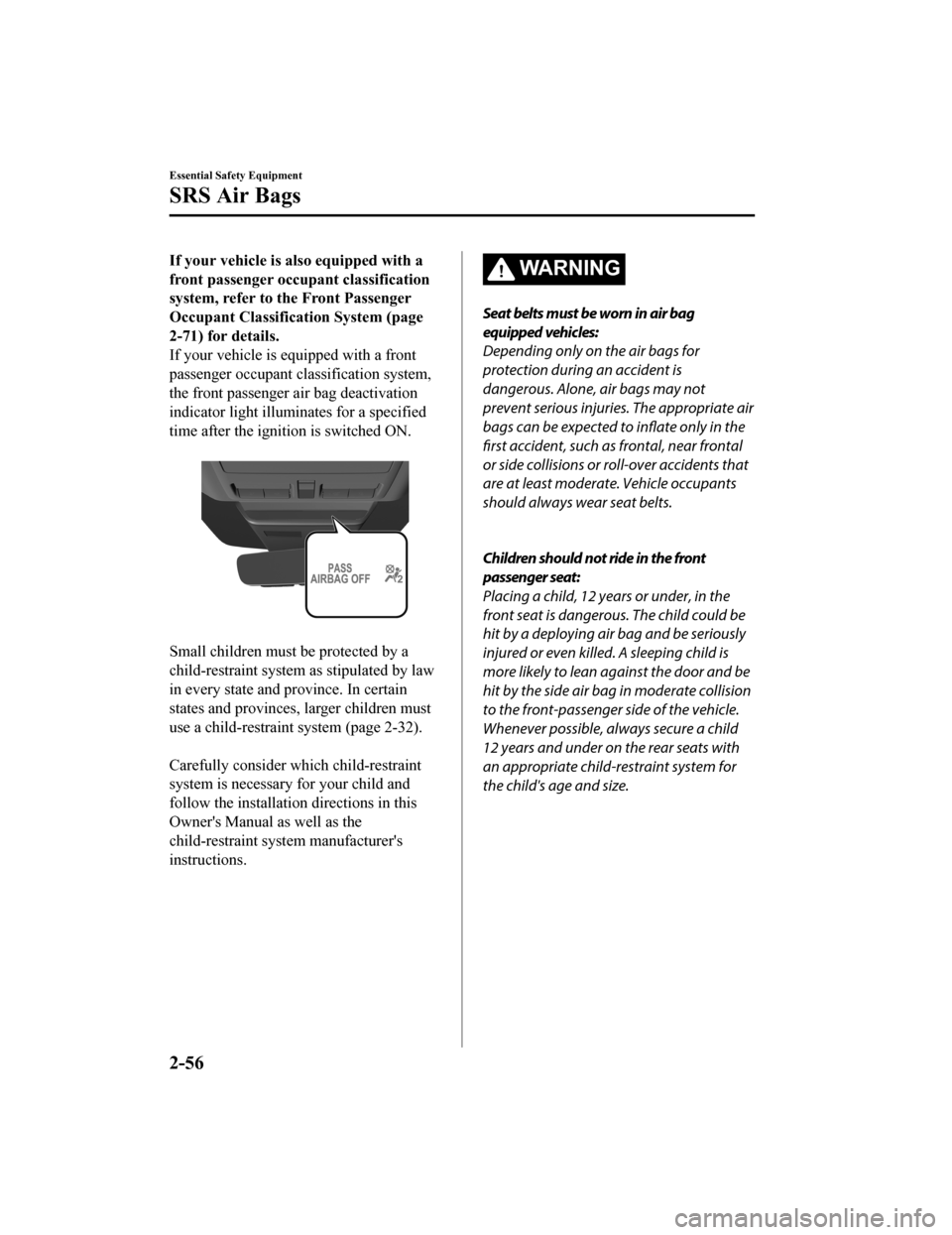
If your vehicle is also equipped with a
front passenger occupant classification
system, refer to the Front Passenger
Occupant Classification System (page
2-71) for details.
If your vehicle is equipped with a front
passenger occupant classification system,
the front passenger air bag deactivation
indicator light illuminates for a specified
time after the ignition is switched ON.
Small children must be protected by a
child-restraint system as stipulated by law
in every state and province. In certain
states and provinces, larger children must
use a child-restraint system (page 2-32).
Carefully consider wh ich child-restraint
system is necessary for your child and
follow the installation directions in this
Owner's Manual as well as the
child-restraint syst em manufacturer's
instructions.
WA R N I N G
Seat belts must be worn in air bag
equipped vehicles:
Depending only on the air bags for
protection during an accident is
dangerous. Alone, air bags may not
prevent serious injuries. The appropriate air
bags can be expected to inflate only in the
first accident, such as frontal, near frontal
or side collisions or roll-over accidents that
are at least moderate. Vehicle occupants
should always wear seat belts.
Children should not ride in the front
passenger seat:
Placing a child, 12 years or under, in the
front seat is dangerous. The child could be
hit by a deploying air bag and be seriously
injured or even killed. A sleeping child is
more likely to lean against the door and be
hit by the side air bag in moderate collision
to the front-passenger side of the vehicle.
Whenever possible, always secure a child
12 years and under on the rear seats with
an appropriate child-restraint system for
the child's age and size.
Essential Safety Equipment
SRS Air Bags
2-56
Mazda3_8HZ1-EA-19G_Edition1_old 2019-5-17 13:49:03
Page 73 of 598

Never use a rear-facing child-restraint
system in the front seat with an air bag
that could deploy:
Rear-facing child-restraint systems on the
front seat are particularly dangerous even
though you may feel assured that a front
passenger air bag will not deploy based on
the fact that the front passenger air bag
deactivation indicator light illuminates.
The child-restraint system can be hit by a
deploying air bag and moved violently
backward resulting in serious injury or
death to the child.
Do not sit too close to the driver and front
passenger air bags:
Sitting too close to the driver and front
passenger air bag modules or placing
hands or feet on them is extremely
dangerous. The driver and front passenger
air bags inflate with great force and speed.
Serious injuries could occur if someone is
too close. The driver should always hold
onto only the rim of the steering wheel. The
front seat passenger should keep both feet
on the floor. Front seat occupants should
adjust their seats as far back as possible
and always sit upright against the
seatbacks with seat belts worn properly.
Sit in the center of the seat and wear seat
belts properly:
Sitting too close to the side air bag modules
or placing hands on them, or sleeping up
against the door or hanging out the
windows is extremely dangerous. The side
and curtain air bags inflate with great force
and speed directly expanding along the
door on the side the car is hit. Serious injury
could occur if someone is sitting too close
to the door or leaning against a window, or
if rear seat occupants grab the sides of the
front seatbacks. Give the side and curtain
air bags room to work by sitting in the
center of the seat while the vehicle is
moving with seat belts worn properly.
Do not attach objects on or around the
area where driver and front passenger air
bags deploy:
Attaching an object to the driver and front
passenger air bag modules or placing
something in front of them is dangerous. In
an accident, an object could interfere with
air bag inflation and injure the occupants.
Do not attach objects on or around the
area where a side air bag deploys:
Attaching objects to the front seat in such a
way as to cover the outboard side of the
seat in any way is dangerous. In an
accident the object could interfere with the
side air bag, which inflates from the
outboard side of the front seats, impeding
the added protection of the side air bag
system or redirecting the air bag in a way
that is dangerous. Furthermore, the bag
could be cut open releasing the gas.
Essential Safety Equipment
SRS Air Bags
2-57
Mazda3_8HZ1-EA-19G_Edition1_old 2019-5-17 13:49:03
Page 76 of 598
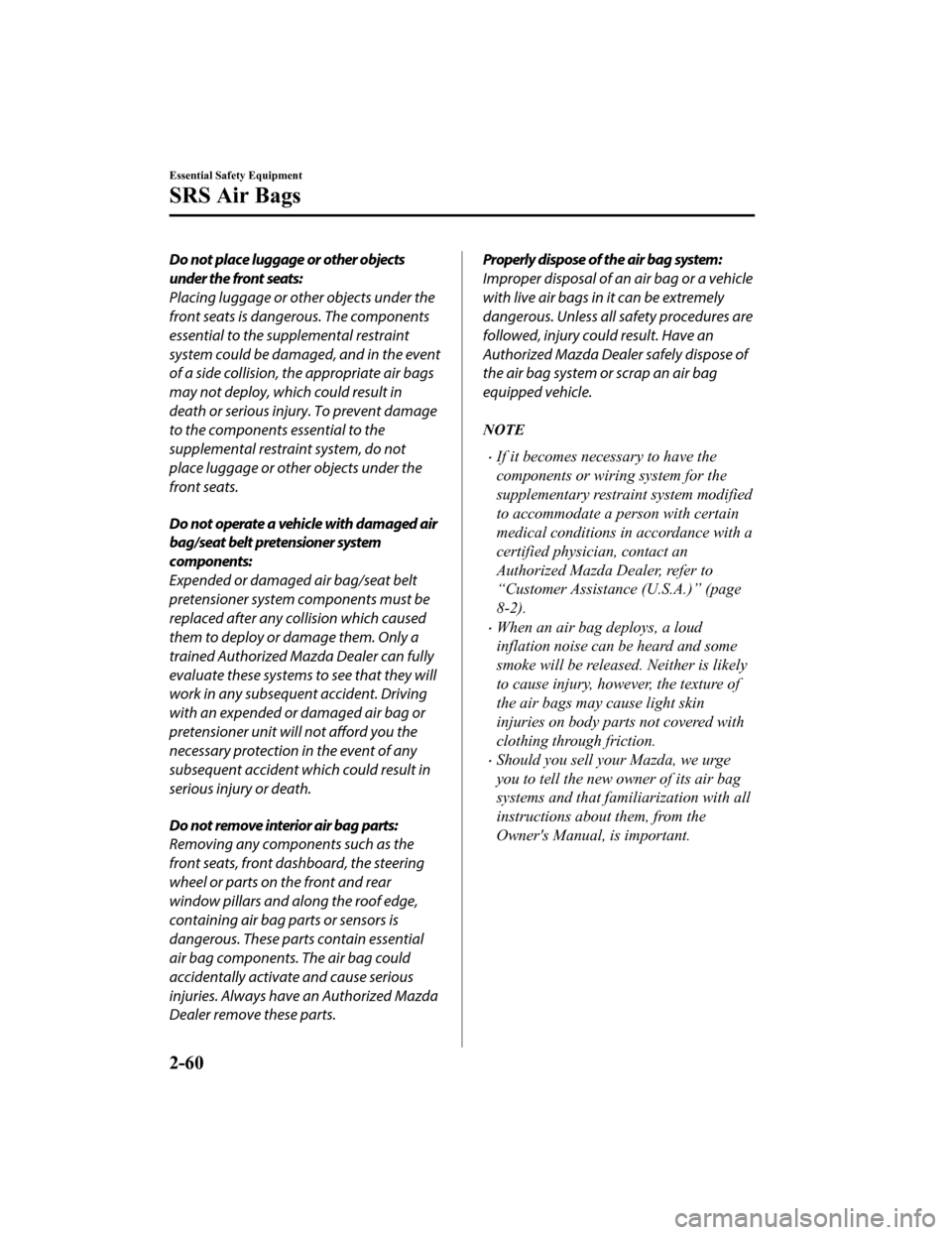
Do not place luggage or other objects
under the front seats:
Placing luggage or other objects under the
front seats is dangerous. The components
essential to the supplemental restraint
system could be damaged, and in the event
of a side collision, the appropriate air bags
may not deploy, which could result in
death or serious injury. To prevent damage
to the components essential to the
supplemental restraint system, do not
place luggage or other objects under the
front seats.
Do not operate a vehicle with damaged air
bag/seat belt pretensioner system
components:
Expended or damaged air bag/seat belt
pretensioner system components must be
replaced after any collision which caused
them to deploy or damage them. Only a
trained Authorized Mazda Dealer can fully
evaluate these systems to see that they will
work in any subsequent accident. Driving
with an expended or damaged air bag or
pretensioner unit will not afford you the
necessary protection in the event of any
subsequent accident which could result in
serious injury or death.
Do not remove interior air bag parts:
Removing any components such as the
front seats, front dashboard, the steering
wheel or parts on the front and rear
window pillars and al ong the roof edge,
containing air bag parts or sensors is
dangerous. These parts contain essential
air bag components. The air bag could
accidentally activate and cause serious
injuries. Always have an Authorized Mazda
Dealer remove these parts.Properly dispose of the air bag system:
Improper disposal of an air bag or a vehicle
with live air bags in it can be extremely
dangerous. Unless all safety procedures are
followed, injury could result. Have an
Authorized Mazda Deal er safely dispose of
the air bag system or scrap an air bag
equipped vehicle.
NOTE
If it becomes necessary to have the
components or wiring system for the
supplementary restraint system modified
to accommodate a person with certain
medical conditions in accordance with a
certified physician, contact an
Authorized Mazda Dealer, refer to
“Customer Assistance (U.S.A.)” (page
8-2).
When an air bag deploys, a loud
inflation noise can be heard and some
smoke will be released. Neither is likely
to cause injury, however, the texture of
the air bags may cause light skin
injuries on body parts not covered with
clothing through friction.
Should you sell your Mazda, we urge
you to tell the new owner of its air bag
systems and that familiarization with all
instructions about them, from the
Owner's Manual, is important.
Essential Safety Equipment
SRS Air Bags
2-60
Mazda3_8HZ1-EA-19G_Edition1_old 2019-5-17 13:49:03
Page 78 of 598
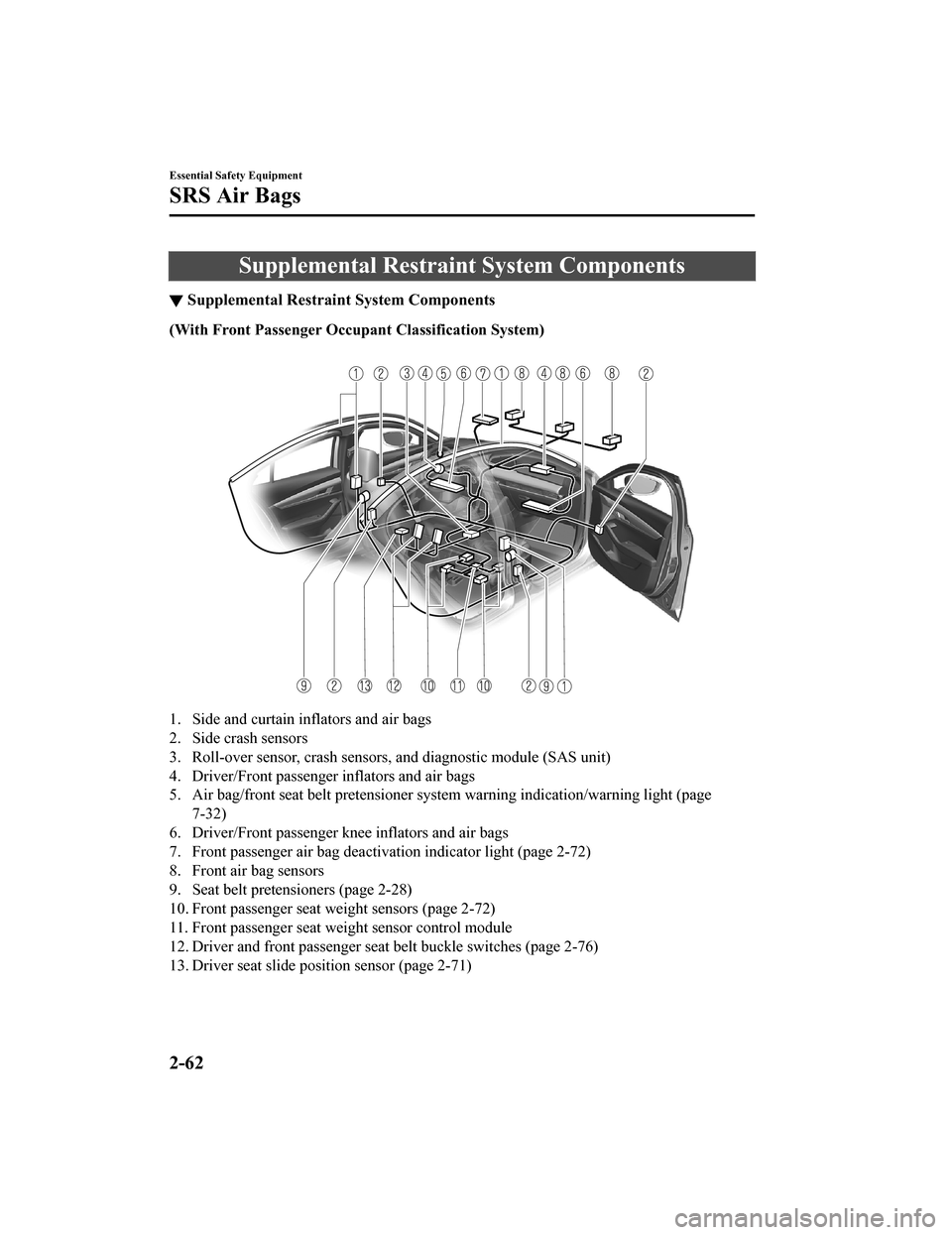
Supplemental Restraint System Components
▼Supplemental Restraint System Components
(With Front Passenger Occupa
nt Classification System)
1. Side and curtain inflators and air bags
2. Side crash sensors
3. Roll-over sensor, crash sensors, and diagnostic module (SAS u nit)
4. Driver/Front passenger inflators and air bags
5. Air bag/front seat belt preten sioner system warning indication/warning light (page
7-32)
6. Driver/Front passenger knee inflators and air bags
7. Front passenger air bag deactivation indicator light (page 2- 72)
8. Front air bag sensors
9. Seat belt pretensioners (page 2-28)
10. Front passenger seat wei ght sensors (page 2-72)
11. Front passenger seat weight sensor control module
12. Driver and front passenger seat belt buckle switches (page 2 -76)
13. Driver seat slide position sensor (page 2-71)
Essential Safety Equipment
SRS Air Bags
2-62
Mazda3_8HZ1-EA-19G_Edition1_old 2019-5-17 13:49:03
Page 79 of 598
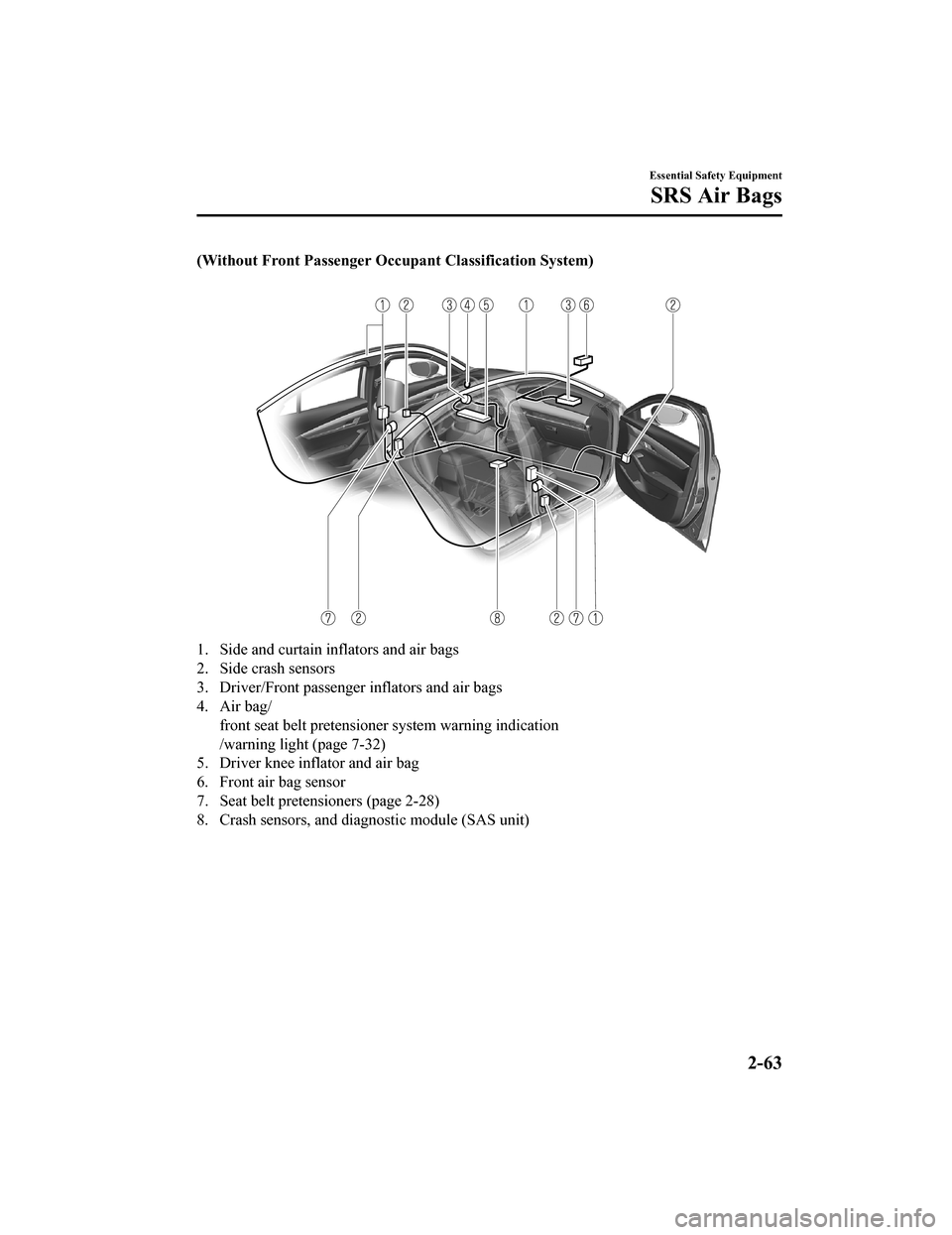
(Without Front Passenger Occupant Classification System)
1. Side and curtain inflators and air bags
2. Side crash sensors
3. Driver/Front passenger inflators and air bags
4. Air bag/
front seat belt pretensioner system warning indication
/warning light (page 7-32)
5. Driver knee inflator and air bag
6. Front air bag sensor
7. Seat belt pretensioners (page 2-28)
8. Crash sensors, and diagnostic module (SAS unit)
Essential Safety Equipment
SRS Air Bags
2-63
Mazda3_8HZ1-EA-19G_Edition1_old 2019-5-17 13:49:03
Page 83 of 598
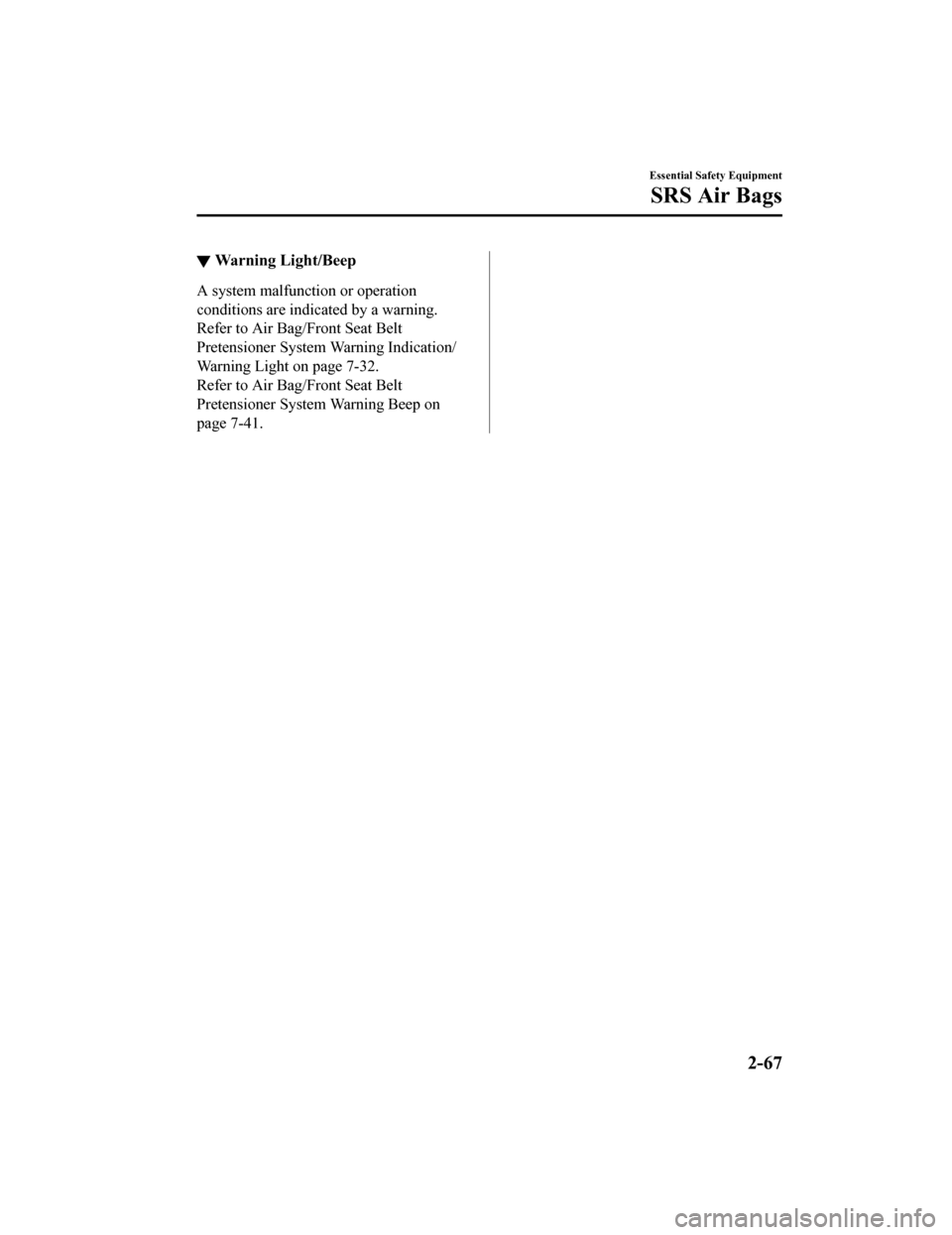
▼Warning Light/Beep
A system malfunction or operation
conditions are indicated by a warning.
Refer to Air Bag/Front Seat Belt
Pretensioner System Warning Indication/
Warning Light on page 7-32.
Refer to Air Bag/Front Seat Belt
Pretensioner System Warning Beep on
page 7-41.
Essential Safety Equipment
SRS Air Bags
2-67
Mazda3_8HZ1-EA-19G_Edition1_old
2019-5-17 13:49:03
Page 87 of 598

Limitations to roll-over detection (With
Front Passenger Occupant
Classification System):
The following illustration is an example of
an accident that may not be detected as a
roll-over accident. Therefore, the front
seat belt pretensioners and curtain air bags
may not deploy.
Pitch end over end
Driver and Front
Passenger Occupant
Classification System
*
▼ Driver and Front Passenger
Occupant Classification System
First, please read "Supplemental Restraint
System (SRS) Precau
tions" (page 2-55)
carefully.
▼ Driver Seat Slide Position Sensor
Your vehicle is equipped with a driver seat
slide position sensor as a part of the
supplemental restrain
t system. The sensor
is located under the driver seat.
The sensor determines whether the driver
seat is fore or aft of a reference position
and sends the seat position to the
diagnostic module (SAS unit).
The SAS unit is designed to control the
deployment of the driver air bag
depending on how close the driver seat is
to the steering wheel.
The air bag/front seat belt pretensioner
system warning light flashes if the sensor
has a possible malfunction (page 2-67).
Essential Safety Equipment
SRS Air Bags
*Some models.2-71
Mazda3_8HZ1-EA-19G_Edition1_old 2019-5-17 13:49:03
Page 88 of 598
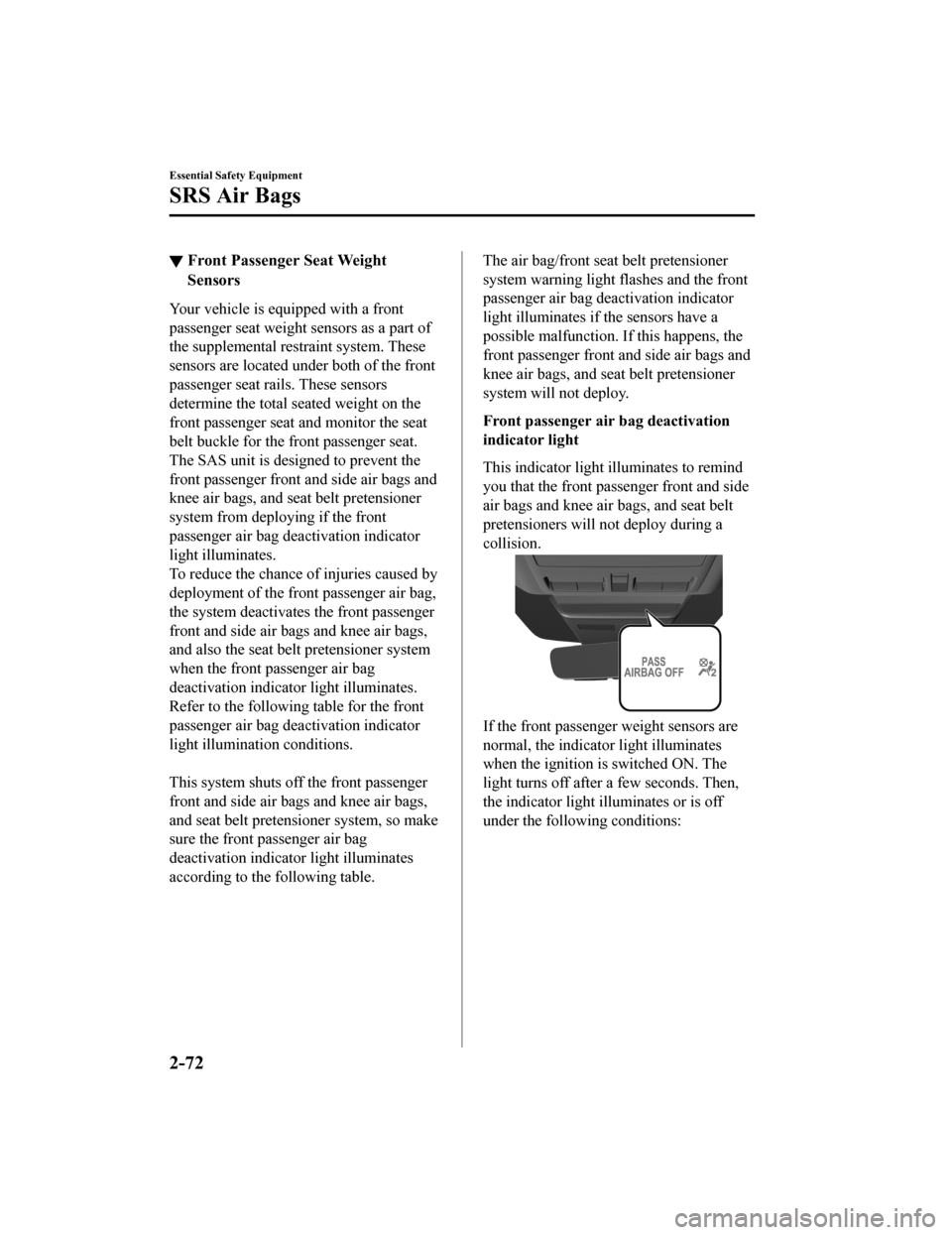
▼Front Passenger Seat Weight
Sensors
Your vehicle is equipped with a front
passenger seat weight sensors as a part of
the supplemental restraint system. These
sensors are located under both of the front
passenger seat rails. These sensors
determine the total
seated weight on the
front passenger seat and monitor the seat
belt buckle for the front passenger seat.
The SAS unit is designed to prevent the
front passenger front and side air bags and
knee air bags, and seat belt pretensioner
system from deploying if the front
passenger air bag deactivation indicator
light illuminates.
To reduce the chance of injuries caused by
deployment of the fr ont passenger air bag,
the system deactivates the front passenger
front and side air bags and knee air bags,
and also the seat belt pretensioner system
when the front passenger air bag
deactivation indicator light illuminates.
Refer to the following table for the front
passenger air bag deactivation indicator
light illumination conditions.
This system shuts off the front passenger
front and side air bags and knee air bags,
and seat belt pretensioner system, so make
sure the front passenger air bag
deactivation indicator light illuminates
according to the following table.
The air bag/front seat belt pretensioner
system warning light flashes and the front
passenger air bag deactivation indicator
light illuminates if the sensors have a
possible malfunction. If this happens, the
front passenger front and side air bags and
knee air bags, and seat belt pretensioner
system will not deploy.
Front passenger air bag deactivation
indicator light
This indicator light illuminates to remind
you that the front passenger front and side
air bags and knee air bags, and seat belt
pretensioners will not deploy during a
collision.
If the front passenger weight sensors are
normal, the indicator light illuminates
when the ignition is switched ON. The
light turns off after a few seconds. Then,
the indicator light illuminates or is off
under the following conditions:
Essential Safety Equipment
SRS Air Bags
2-72
Mazda3_8HZ1-EA-19G_Edition1_old 2019-5-17 13:49:03